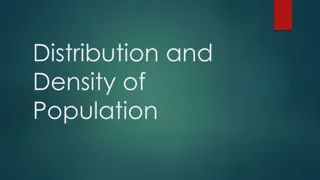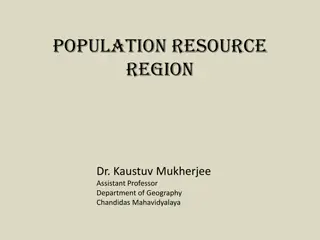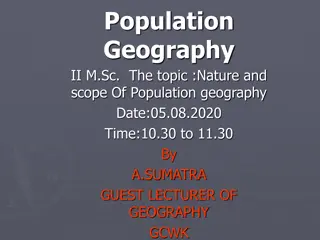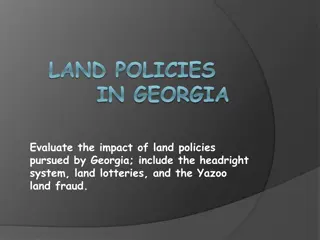Overview of the South African National Population Register
The South African National Population Register (NPR) is a vital system maintained by the Department of Home Affairs. It serves to record and update information on the country's resident population, issue identity documents, and handle related administrative tasks. The NPR has evolved over the years
2 views • 16 slides
Alberta Home Care Policy Revision 2023 Overview
The Alberta Home Care Policy Revision 2023 presentation delves into the background, acknowledgements, and validation process of the revised policies. It highlights the adaptation of policies from the 2002 Alberta FNIHCC Program Policies Manual and recognizes the contributions of various individuals
0 views • 33 slides
Distribution and Density of Population.
Population distribution and density are closely related concepts that describe the spatial patterns and proportional relationships of human populations across the world. Factors such as physical landscapes, socio-cultural influences, and demographic trends contribute to the regional disparities in p
8 views • 9 slides
Understanding Population Ecology and Demography Through Leslie Matrices
Explore the critical aspects of population ecology and demography, focusing on factors influencing abundance, population growth, regulation, and the impacts of climate change. Learn about population projections, growth models, age-structured populations, and data requirements for estimating populati
4 views • 35 slides
Population Characteristics and Control in Pakistan
The population of Pakistan exhibits high birth rates and declining death rates, leading to a significant natural increase. Urbanization is rapidly occurring while literacy rates remain low. There is a crucial need for population control to ensure economic progress and prosperity. However, addressing
0 views • 7 slides
Factors Influencing Population Change in Chapter 24
This chapter explores key factors affecting population change including food supply, technology, healthcare, war, status of women, and education. It discusses how improved technology, healthcare advancements, and food availability impact population growth, as well as the demographic transition model
0 views • 40 slides
Impact of Human Population Growth on Environment and Welfare
The rapid growth of the human population is placing immense pressure on the environment, leading to increased demand for resources like food, water, and shelter. The effects of human activity on the environment have escalated significantly over the years due to population expansion. High birth rates
0 views • 8 slides
Population Growth in India: Challenges and Implications
Overpopulation is a pressing issue globally, with India being the 2nd most populous country. The rapid population growth is linked to challenges such as poverty and hindered development. Concepts like population explosion and demographic transition shed light on the dynamics. India's population grow
0 views • 36 slides
Overview of 2020 Census Post-Census Group Quarters Review
The 2020 Post-Census Group Quarters Review (PCGQR) is a program developed by the Census Bureau to address discrepancies in group quarters population counts from the 2020 Census. This initiative allows governmental units in the US and Puerto Rico to request a review of their group quarters' populatio
0 views • 12 slides
Exploring Evolution and Population Genetics in AP Biology
Delve into the fascinating world of evolution and population genetics with themes covering natural selection, genetic equilibrium, allele frequencies, and more. Understand how molecular and cellular events shape emergent properties at individual and population levels. Explore the impact of factors l
0 views • 12 slides
Introduction to Sampling in Statistics
Sampling in statistics involves selecting a subset of individuals from a population to gather information, as it is often impractical to study the entire population. This method helps in estimating population characteristics, although it comes with inherent sampling errors. Parameters represent popu
2 views • 24 slides
Understanding Population-Resource-Region Relationship: A Geographical Perspective
Explore the intricate relationship between population, resources, and regions through a geographical lens. Delve into classifications based on population, resources, and technology, with examples from different countries and regions. Discover the concepts of optimum population, over-population, and
1 views • 11 slides
Understanding Mark-Recapture Methods for Estimating Population Abundance
This content explores the concept of estimating population abundance using mark-recapture methods. It covers various aspects such as natural mortality, recruitment, fishing mortality, immigration, and emigration. The process involves marking animals in one sample, allowing them to integrate back int
0 views • 29 slides
Understanding Demography: Population Trends and Analysis
Demography is the study of population size, distribution, and composition, encompassing elements such as mortality, natality, migration, and demographic forces. Population census plays a crucial role in collecting and analyzing demographic data, with methods like De Jure and De Facto census. Inter-c
6 views • 21 slides
Understanding Population Geography: Nature and Scope
Population geography explores how spatial variations in population distribution, composition, migration, and growth are connected to geographic features. It focuses on the interplay between human societies, the physical environment, and cultural aspects. Factors influencing population distribution i
1 views • 13 slides
Comparing 1750 to 1900: Population Growth in Britain
The population of Britain saw a significant increase between 1750 and 1900. In 1750, the population was 7 million, and by 1900, it had grown to 37 million. This represented an 87% increase. The number of people living in towns also rose from 13% to a higher percentage. Factors contributing to this g
0 views • 6 slides
The Case for Population Registers: Key Requirements and Implementation Status Across Africa
Population registers play a crucial role in providing robust and timely population data, especially in the current era emphasizing rigorous measurement and monitoring of human development. Implementing e-government platforms and facing challenges like the Covid-19 pandemic have highlighted the impor
0 views • 18 slides
Population Resource Regions and Zelinsky's Classification
Geographers have long studied the relationship between population growth and resource adequacy, leading to the concept of Population Resource Regions (PRR) by W. Zelinsky. Zelinsky identified five types of PRR based on population-resource ratios, ranging from Type A with high resource utilization po
0 views • 8 slides
Understanding Population Policies and Their Impact on Growth Theories
Explore the various government policies - Expansive, Eugenic, and Restrictive - that influence population growth. Discover how these policies encourage or limit natural increase, such as promoting large families or imposing birth control measures. Learn about historical examples like China's one-chi
0 views • 17 slides
Population Distribution in Different Regions of Pakistan
The population distribution in Pakistan varies significantly among different regions, with certain provinces like Punjab and Sindh having higher population densities compared to Baluchistan and FATA. The rural areas are also categorized into different population density regions based on the number o
0 views • 14 slides
Exploring Human Geography: Culture, Population, and Places
Delve into the diverse elements of human geography, from the intricacies of culture including food, religion, and language to the dynamics of population geography like natural increase rates and population density. Gain insights into political, urban, and economic geography as you discover where the
0 views • 39 slides
Understanding Sampling Theory: An Introduction to Statistical Surveys
Statistical surveys play a crucial role in collecting information to fulfill specific needs across various fields such as population demographics, labor statistics, agriculture, industry, and trade. A statistical survey involves investigating unknown characteristics of a population, focusing on para
0 views • 41 slides
Methods of Population Forecasting for Urban Development
Designing water supply and sanitation schemes for cities requires accurate population forecasting. Factors influencing population changes include births, deaths, migration, and annexation. Various methods like Arithmetic Increase, Geometric Increase, and Ratio Method are used to predict population g
4 views • 24 slides
Understanding the Concept of Population and Unit Stock
The concept of population revolves around all organisms of the same species living in a specific area capable of interbreeding. It is essential to differentiate between sample populations and real populations to accurately study their attributes such as birth rates, death rates, and spatial dimensio
0 views • 15 slides
Population Policy of Pakistan: Vision, Goals, and Strategies
The Population Policy of Pakistan, adopted in 2002, aims to stabilize the population by 2020 through a focus on reducing fertility rates and promoting family planning. The policy outlines goals such as achieving a balance between resources and population, increasing awareness of rapid population gro
0 views • 11 slides
Exploring Population Data of the Czech Republic
The data presents insights into the population of the Czech Republic, including demographics, language distribution, religious beliefs, literacy rates, life expectancy, and urban population percentages. The population pyramid reveals a dominance of people in the age group of 20-49, with longer life
0 views • 8 slides
Thomas Malthus and His Theory on Population Growth
Thomas Robert Malthus, an influential economist, proposed a theory on population growth in the 18th century. His theory suggested that population grows exponentially while food production increases at a slower rate, leading to inevitable food scarcity. Malthus also discussed the concept of preventiv
2 views • 19 slides
Implementing Smoke and Tobacco-Free Policies on College Campuses
Explore the growing momentum of implementing smoke and tobacco-free policies on college campuses across the country, with examples from leading health organizations and steps to form and enforce these policies effectively. Learn about the dos and key considerations in adopting such policies and acce
1 views • 33 slides
Louisiana Parish Population Statistics 2010
Louisiana Parish Population Statistics for the year 2010 reveal varying population numbers across different regions. The data provides insights into demographic changes and trends over the past decade. The total population change by parish and age group highlights shifts in different age brackets. T
0 views • 42 slides
Improvement of Population and Vital Statistics Metadata in the Demographic Yearbook System
The Demographic Yearbook system focuses on enhancing population and vital statistics metadata to ensure accurate and concise reflection of population concepts across 230+ countries. It involves annual collection of official national population estimates, vital statistics, and UN international travel
0 views • 16 slides
Understanding Logistic Growth in Population Dynamics
Explore the logistic growth equation and its applications in modeling population dynamics. Dive into the concept of sigmoidal growth curves and the logistic model, which reflects population growth with limits. Learn how to calculate population change using the logistic growth equation and understand
0 views • 26 slides
Insights on 2019 Gender and Veteran Demographics
Analysis from the 2019 Annual Averages of the Current Population Survey reveals significant statistics regarding gender and veteran populations in the United States. Data indicates that veterans comprise 7.5% of the overall population, with women veterans totaling almost 2 million. Women veterans ma
0 views • 48 slides
Impact of Land Policies in Georgia: Headright System, Land Lotteries, and Yazoo Land Fraud
Georgia pursued various land policies post-Revolutionary War to allocate land obtained from Native Americans. The headright system granted land to soldiers and white men, aiming to boost population and state power. Land lotteries distributed land through random draws. The Yazoo land fraud scandal ta
0 views • 20 slides
Overview of Population Measures and District Data from Census Reports
The census reports various population measures including total population, voting age population, and citizen voting age population. The data includes breakdowns by ethnicity for each trustee district. Changes in voting and citizen voting age population percentages are also provided. Data is sourced
0 views • 4 slides
Understanding Population Pyramids for Analyzing Population Trends
Population pyramids are graphical illustrations that showcase the distribution of age groups within a population, segmented by gender. By observing and documenting the patterns of population pyramids, one can discern trends such as rapid growth, slow growth, or negative growth, which are influenced
0 views • 7 slides
Government Response to Aging Population Care Challenges
The discussion focuses on how the government will address the care challenges posed by an aging population, particularly in the realm of social care. It delves into the social construction of old age, the evolution of policies related to older individuals, the concept of social care, and concerns re
0 views • 31 slides
Population Policies in India: Evolution and Impact
Population policies in India have evolved over the years, focusing on areas such as contraception, health care infrastructure, and integrated service delivery. The policies under different Five-Year Plans have emphasized various approaches, including natural family planning, sterilization techniques
0 views • 7 slides
Maine Workforce and Population Trends Analysis 2014-2024
Maine's workforce and population outlook from 2014 to 2024 reveals a decline in births, resulting in an aging population and workforce imbalance. The state faces challenges due to low birth rates, negative natural population change, and minimal net migration, impacting labor force growth and total p
0 views • 31 slides
The Impact of Family Planning Policies in India
In the mid-1960s, India initiated family planning policies to control population growth, with Sanjay Gandhi leading an aggressive sterilization campaign. The government imposed strict quotas, penalties, and incentives, resulting in millions of sterilizations. Despite initial support, the policy face
0 views • 19 slides
The Global Human Population Explosion: Causes and Implications
The lecture explores the rapid increase in the global human population post-World War II, analyzing factors such as birth rates, mortality rates, and life expectancy. Various counterarguments are presented, including the debate on population growth benefits, ethical concerns over reproductive interf
0 views • 20 slides







































